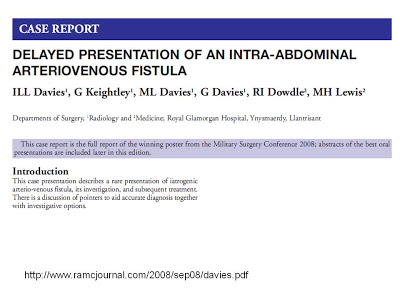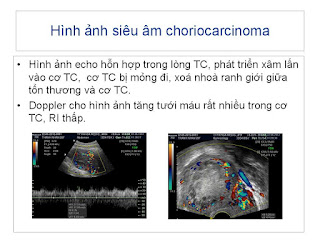The AV fistula had the origine of right internal iliac artery and drains off blood to right internal iliac vein.
DISCUSSION
Arteriovenous malformations (AVMs) of the female pelvis are
uncommon. These may either be congenital or acquired. Congenital pelvic AVMs
are characterised by a large number of arterial feeding branches. The arterial feeders are considered undifferentiated vascular structures
following arrested embryonic development at various stages [1]. Acquired pelvic
AVMs on the other hand, develop following spontaneous rupture of an atherosclerotic aneurysm into the adjacent veins or following
penetrating trauma (less than 20%), e.g. gunshot wound or stabbings, or after
lumbar disc surgery [2]. Therefore, acquired AVMs are most commonly arteriovenous fistulas (AVF). The AVFs are most commonly
aorto-caval fistula, followed by ilio-iliac [3] and aorto-iliac. However, the
etiology, clinical features, pathophysiology, principles of management and postoperative care for these fistulas are similar. Approximately
3 to 4% of all patients undergoing surgery for ruptured aorto-iliac aneurysm
are found to have AVF [3]. These carry a better prognosis than intraperitoneal,
retroperitoneal or enteric rupture of aorto-iliac aneurysms [5]. The disorder
has a marked male preponderance [4]. Other rarer causes of acquired AVFs include
Marfan’s syndrome, Ehler-Danlos syndrome, syphilis, Takayasu’s arteritis, invasion
by malignant tumour [2] and in some the cause is never ascertained.
Pelvic AVMs may manifest with symptoms of pain, haemorrhage,
haematuria, dyspareunia, or congestive heart failure, or symptoms secondary to
mass effect on adjacent pelvic structures. Acquired AVF, secondary to surgery
or trauma, tend to occur in younger patients as trauma or surgery tends to
affect younger patients. In contrast, spontaneous perforation of
atherosclerotic aneurysm into adjacent veins tends to occur in the older population.
Two large series report mean ages of 67.3 [6] and 69.7 years. The time of onset
of symptoms is usually earlier, from hours to weeks [3]. The initial diagnosis
is often that of an abdominal aortic aneurysm, AVF is often not suspected and
often the diagnosis is only made at surgery [5].
Iliac artery aneurysms and ilio-iliac fistulas are usually
associated with abdominal aortic aneurysm, as demonstrated in this case, though
they may occur as isolated entities. Rupture of atherosclerotic aneurysms into
the iliac vein may have three different clinical manifestations: sudden onset
of high output cardiac failure; pulsatile lower abdominal mass associated with bruit and thrill; or unilateral intermittent claudication or
venous congestion. Our patient presented with the first two clinical
manifestations and the tricuspid regurgitation was most likely secondary to
grossly dilated ventricle from high output cardiac failure.
Ultrasound, CT or even MRI is almost always ordered for assessment of the abdominal/iliac aneurysms. Colour Doppler ultrasound has demonstrated the AV fistulas as areas of high velocity turbulent flow with aliasing of colour signal and also shows any associated thrombus at the aneurysm or fistula. Detection of ilio-iliac fistulas may however be difficult, as demonstrated by this case, as these tortuous and aneurysmal vessels lie deep within in the pelvis and obscured by overlying bowel gas. CT angiography is excellent in demonstrating the aneurysm and fistulous communications [6], especially with the advent of multi-detector CT and 3D software. Early contrast opacification of the iliac veins and inferior vena cava, and site of the fistula are clearly visualised.
Conventional angiography still remains the ‘gold standard’
for assessment of AVMs as well as assisting in assessing options for
endovascular management. Endovascular treatment has gained considerable favour in
the management of arteriovenous fistula especially for those with significant
high-risk comorbid factors. Options
available include percutaneous endovascular treatment with covered self-expanding
stent graft to cover the mouth of the fistula. However, this is not always
feasible due to the tortuous iliac vessels. Transcatheter embolisation with
coils or detachable balloons [7] is generally not recommended due to the large
size of the fistula, high flow and short neck.
Surgical options for AVF consist of endo-aneurysmal repair
of the fistula and prosthetic graft replacement of the aortoiliac aneurysm but
these are associated with high morbidity and mortality (approaching 60%) due to
the emergent nature of the procedure [4]. Thus early diagnosis
and appropriate management is of paramount importance. Unlike acquired AVFs, surgical
treatment of congenital AVMs is difficult due to the extensive nature and the
large number of dysplastic feeder vessels with the potential for exsanguinating
haemorrhage and damage to surrounding structures [8]. Accordingly, transcatheter embolisation has
become the treatment of choice [8]. Preoperative embolisation of AVMs has also
been used as an adjunct to decrease intraoperative blood loss. Small asymptomatic
AVMs that do not increase in size may be safely observed.
AVFs between major abdominal vessels are uncommon
complication of aortoiliac aneurysm. Ilio-iliac fistula in a female patient is
even rarer and associated with high morbidity and mortality especially if the
diagnosis is not suspected. In this patient, in the absence of history of
trauma or surgery and the presence of extensive aneurysmal disease involving
the aorta and iliac arteries, it is reasonable to believe that the AV fistula
was secondary to perforation of the aneurysmal right iliac artery into the
right iliac vein. In addition to the rapid onset, the presence of a single
communication and older age group lend more support to this diagnosis.
There has only been a single reported case in the literature
with an ilio-ilial fistula secondary to atherosclerotic disease [5]. In
addition the CT angiographic appearances of ilio-ilial AVF have not been described.
Spontaneous major
intra-abdominal arteriovenous fistulas: a report of several cases, Astarita D, Filippone DR, Cohn JD. Angiology1985, Sep;36(9):656-61.
Most major
intra-abdominal fistulas result from trauma or surgery. Spontaneous fistulas
are rare with less than 100 reported cases since 1831. From a review of
hospital records, five such spontaneous fistulas were identified among 215
cases of abdominal aortic aneurysm between 1975 and 1983. These cases are
presented and supplemented by 73 similar cases collected from a literature
review for discussion of the salient features of clinical presentation and
management of spontaneous major fistulas. Major intra-abdominal arteriovenous
fistulas usually present with a machinery bruit over a pulsatile mass, but may
present more subtly with pain and otherwise unexplained hematuria. Because
these fistulas lead to refractory heart failure, surgery should be expeditious.
Closure should be performed from within the aneurysm with arterial and
pulmonary artery pressure monitoring. Care must be taken to prevent pulmonary
embolization.




























